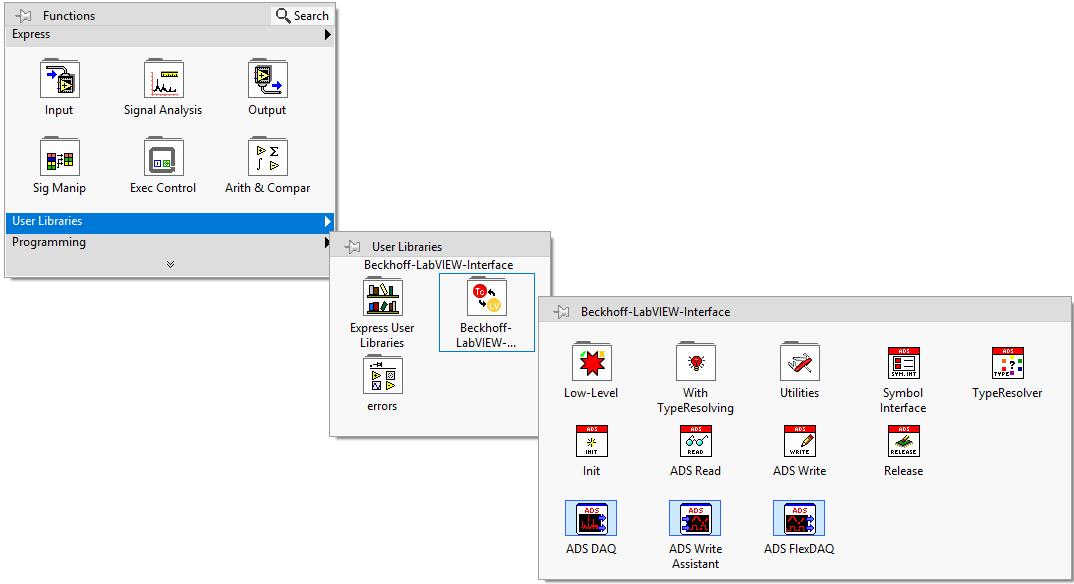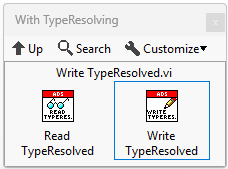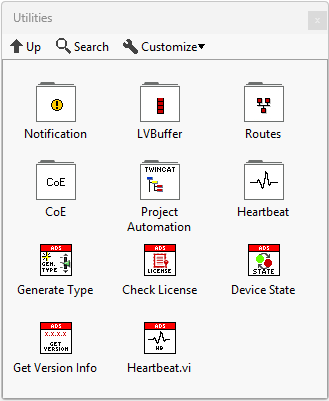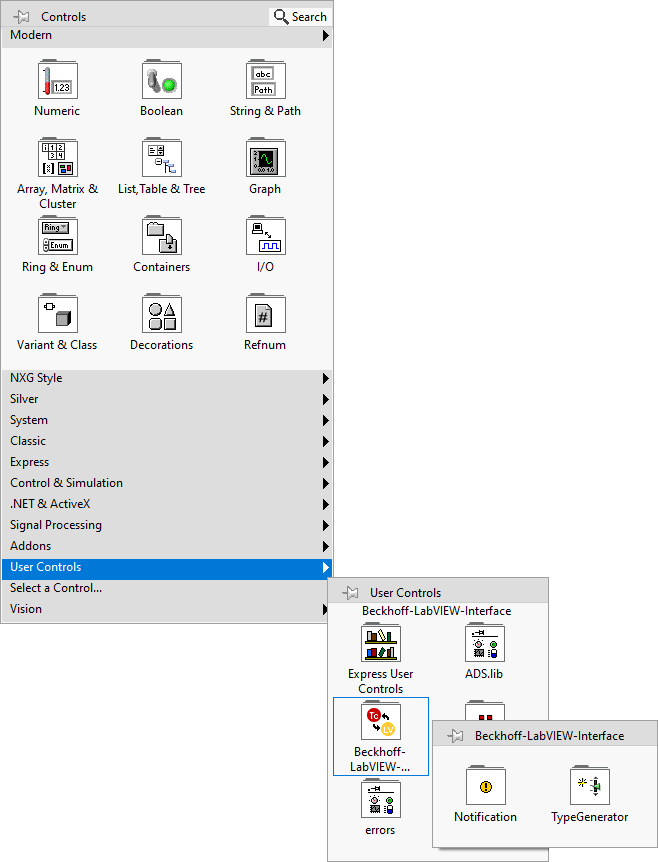LabVIEW™ VIs
The TwinCAT 3 Interface for LabVIEW™ provides controls and VIs for use in LabVIEW™.
The VIs are located in the block diagram in the functions palette: Functions > User Libraries > Beckhoff-LabVIEW-Interface.

The main folder contains the basic VIs that can be used to build a program for reading via ADS, writing via ADS, TypeResolving and releasing the ADS client. In addition, the main folder contains the subfolders: Low-Level, With TypeResolving and Utilities.
Low-Level
The Low-Level subfolder contains Low-Level-VIs. The low-level VIs operate based the same principle as the basic VIs. The low-level VIs involve a little more programming effort but offer higher performance (in terms of data throughput) than the basic VIs and more flexibility for realizing complex programs. Reading with Polling Cycle is an example that uses low-level VIs for fast reading via ADS. Writing with polling cycle is a similar example. Not only reading and writing can be accelerated in this way, but also TypeResolving, see Continous Read, for example.
The table describes the subfolders and their contents and function:
Subfolder | VIs | Function |
|---|---|---|
Base Init | Initializes the ADS client. | |
Get List of ReadWrite Symbols | Creates a list of ADS read and write symbols. | |
Get List of Registered Targets | Creates a list of registered ADS target systems. | |
Init Reader | Initializes the ADS Reader. | |
Send Reader-Request | Sends a request to the ADS server. | |
Register Notification | Registers the notification on the ADS server. | |
TryReadData | Checks the response from the server and reads the data stream. | |
Release Reader | Releases the reader from memory. | |
Init Writer | Initializes the ADS Writer. | |
Send Writer Request | Sends a request to the ADS server. | |
CheckWriteStatus | Checks for the response from the ADS server to ascertain whether the data packet was received. | |
Release Writer | Releases the writer from memory. | |
Init SumUp | Initializes the ADS-SumUp. | |
Add SubCommand | Adds a new command to the SumUp. | |
Put Data | Puts new data to the initialized command that is to be written to TwinCAT. | |
Get Data | Gets data from a SumUp command that was read from TwinCAT. | |
Enable Autosend | Enables automatic sending of SumUp commands. | |
Send SumpUp | Sends all SumUp commands to the TwinCAT runtime. | |
Release SumUp | Releases the SumUp handle in the memory. | |
Init Type | Initializes the TypeResolver. | |
Resolve From TC Type | Converts the TwinCAT 3 data type to a LabVIEW™ data type variant. | |
Resolve To TC Type | Converts the LabVIEW™ data type variant into a TwinCAT 3 data type. | |
Release Type | Releases the TypeResolver from memory. |

With TypeResolving
The With TypeResolving subfolder contains two VIs for reading and writing via ADS with integrated TypeResolver block.

Utilities
The Utilities subfolder contains additional VIs for the following purposes:
Subfolder | VIs | Function |
|---|---|---|
ADS To LabVIEW Timestamp | Converts ADS timestamps to LabVIEW™ timestamps. | |
Notification Data To Variant Array | Builds an array of LabVIEW™Variant from the notification data stream. | |
Stop Notification | Stops the ADS notifications. | |
Start Notification | Starts the ADS notifications. | |
Unregister Notification | Unregisters the notification on the server. | |
LVBuffer | Init LVBuffer Handle | Initializes a handle for reading an ADS notification using the LabVIEW™-side data buffer. |
Read From LVBuffer | Reading data from the data buffer | |
LVBuffer status | Reading the number of samples in the data buffer | |
Release LVBuffer Handle | Releases the handle to the data buffer | |
Routes | Get Routes | Reads all target systems that are connected to the local TwinCAT system. |
Get Route Info | Specifies all subsystems and ports for a target system. | |
CoE | Read CoE List | Reads a CoE directory of a terminal and lists the available CoE objects. |
Read CoE Description | Reads the description of a CoE object and specifies the sub-elements. | |
Read CoE Entry | Reads an entry from a CoE directory and outputs the properties. | |
Read CoE Value | Reads the value of a CoE entry. | |
Write CoE Value | Writes the value of a CoE entry. | |
Project Automation | Init Project | Initializes a TwinCAT 3 engineering project. Either an existing project is opened or a new one is created. |
Create Task | Creates a task in a TwinCAT 3 project or changes the task parameters. | |
Scan IO | Checks existing inputs and outputs on the target system and adds them to the project tree. | |
Create PLC | Creates a PLC within a TwinCAT 3 project. | |
Activate Solution | Activating a TwinCAT 3 project. | |
Release Project | Releases the handle to the TwinCAT 3 project. | |
Heartbeat | Init Heartbeat | Creates a Heartbeat instance with a handle. |
Run Heartbeat | Starts connection monitoring. | |
Stop Heartbeat | Stops connection monitoring. | |
Release Heartbeat | Releases the handle to the Heartbeat instance from memory. | |
Get RTD Estimate | Indicates the current estimate of the Round Trip Delay. | |
| Heartbeat | Initializes, starts and stops connection monitoring in a VI. |
| Generate Type | Generates a corresponding constant or control with the LabVIEW™ data types for a symbol using the TypeInfo of the TypeResolver. |
| Check License | Checks the license state on a given target system. |
Set Device State, | Reads or changes the state of an ADS device. | |
Get Version Info | Provides information regarding the product version. |

Controls
The controls are located in the front panel in the controls palette under: User Controls > Beckhoff-LabVIEW-Interface.

The Notification subfolder contains controls that are required when initializing the LabVIEW™ event for ADS notifications.
Furthermore, the subfolder “TypeGenerator” contains TypeGenerator class objects to convert TwinCAT types into LabVIEW™ types (see Generate LabVIEW™ type).
The following table describes the function of the controls:
Subfolder | Controls | Function |
|---|---|---|
Notification | Single User-Event Data | Control for initializing a LabVIEW™ event for Single ADS notifications. |
Buffered User-Event Data | Control for initializing a LabVIEW™ event for Buffered ADS notifications. | |
TypeGenerator | CBase | Class object; base class of the TypeGenerator |
CBool | Class object; Boolean class of the TypeGenerator. | |
CNumeric | Class object; numeric class of the TypeGenerator. | |
CString | Class object; LabVIEW™ string class of the TypeGenerator. | |
CArray | Class object; array class of the TypeGenerator. | |
CTimestamp | Class object; LabVIEW™ timestamp class of the TypeGenerator. | |
CCluster | Class object; LabVIEW™ cluster class of the TypeGenerator. |